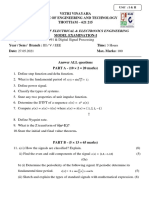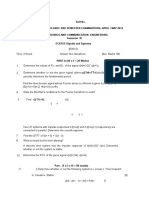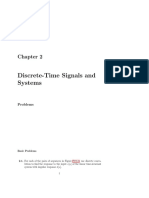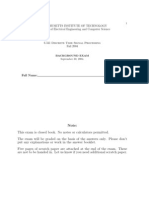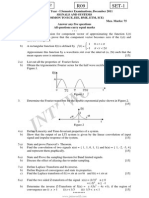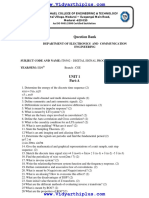0 ratings0% found this document useful (0 votes)
15 views7 pagesModule4 Signal System
Signals and System Note 4
Uploaded by
shubhayubasak518Copyright
© © All Rights Reserved
We take content rights seriously. If you suspect this is your content, claim it here.
Available Formats
Download as PDF or read online on Scribd
0 ratings0% found this document useful (0 votes)
15 views7 pagesModule4 Signal System
Signals and System Note 4
Uploaded by
shubhayubasak518Copyright
© © All Rights Reserved
We take content rights seriously. If you suspect this is your content, claim it here.
Available Formats
Download as PDF or read online on Scribd
You are on page 1/ 7
21
2.
23.
25.
26.
21.
28.
29,
30.
| Signats and Systems
(©) bandwidth,
average of minimum and maximum frequencies
id pass signal extending from 5 kHz to 15 kHz is to be sampled at
2 (b) 15 kHz
© 202 (@) between 5 KHz and 15 kHz
The Nyquist\rate for the signal x(?) = 5 sin 200zt + 8 cos 50Ozt is
(@) 200 Hz (b) 500 Hz (c) 700 Hz (@) 300 Hz
The Nyquist rate fx the signal x(t) = 3 sin 300z¢ x 8 cos 700z1 is
(a) 1000 Hz, 300 Hz. (©) 700 Hz (@) 1400 He
}. The Nyquist rate for the signal x(t) = 6 sin? 400zt cos 2001 is
(a) 400 Hz ® 1 (©) 200 Hz (@) 800 He,
‘The Nyquist rate for the signal x 5c) sneoe is
(a) 300 Hz (b) 600 Hz (©) 500 Hz @ 60000 Hz
‘The Nyquist rate for the signal x(¢) = 5 sinc¥®QOt) + 3 sinc®(700z7) is
(@) 1400 Hz (b) 49000 Hz (© S00 Hz @ 900 Hz
‘The Nyquist rate for the signal x(2) = 4 sinc?(50071) Yag(200zm1) is
(a) 1000 Hz (b) 1200 Hz (©) 700 Hz @ 250000 Hz
‘The Nyquist interval for the signal x(¢) = 20850020).
(a) 500s (b) 0.002s © 0.001s @o
The Nyquist interval for the signal x(¢) = cos(500z¢) + sinc?(200x¢) is
(a) 0.002 s (b) 0.0025 s (c) 0.005 s (@) 0.007 s
The Nyquist interval for the signal x(0) = 2 sine(200z) sinc®(400m)) is
(a) 0.005 s (b) 0.0025 s (©) 0.001 s (@) 0.00125 s
PROBLEMS
A signal having a spectrum ranging from de to 20 KE. is to, be sampled and converted
into discrete form, What is the minimum number of samples per second that must be
taken to ensure recovery?
‘The signal x2) = 10 cos(20z#) is sampled at a rate of 15 samples per second. Plot the
amplitude spectrum for |e} < 607. Can the original signal be recovered from samples?
Explain,
. A signal x( = sin(200z1) is sampled at a rate of (a) 150 Hz. (b) 225 Hz (c) 300 Hz, For
each of these three cases, can you recover the signal x(0) from the sampled signal
x?
Sampling | $89
4, Draw [X,(0)] for the signal x(#) with X(@) shown in Figure 8.36 for the following cases
when 3,(0 = x(¢) 8142) with sampling period 7, where
d= 3 60-02)
@ 1T=Zsee (e) T=Fsec ©) T=Zsee
xo)
~4 fo
Figure 8.36 Problem 4.
5. Consider the following sampling and reconstruction block shown in Figure 8.37(a).
xO a0 Weal | @
° reconstruction
|____ filter eet
au
1 Ha) |
Tr
vie!
et
@ ©
Figure 837 Problem 5.
‘The output of the ideal reconstruction filter can be found by sending signal »,(¢) through.
an ideal low pass filter having characteristics as shiown in Figure 8.37(b). For the
following signals draw the spectrum {X,(c)| and find expressions for x(nT) and y(1):
(a) x(1) = 1 + cos SOmr for T = 0.025 sec
(b) xf) = 1 + cos 100m for T = (1/75) sec
Ac) xf) = 2 + cos 20mt + cos 60m for T = 0.025 sec
@ If X(@) = 14 + jad) and T = 4 seo, draw |X,(a)|. Test for aliasing.
6. Determine the Nyquist sampling rate and Nyquist sampling interval for the following
signals:
(@) -sinc?(30021) () Ssine?(30022)
Xe) sine(i00z1) + 5 sine*(2001) (@)_sine(60z1) sinc(1401)
590 | Signals and Systems
7. Consider a continuous-time signal x(¢) with frequency spectrum shown in Figure 8.38,
Find the frequency spectrum ‘of its sampled sequences if the sampling frequency
(a) @, = 40 radisec. (b) @, = 80 rad/sec. (c) @, = 120 rad/sec. Also find in which cases
the signal x(r) can be recovered from its samples.
x(a)
Figure 8.38. Problem 7.
8. The amplitude spectrum of a continuous-time signal is shown in Figure 8.39. When this
signal is sampled with a sampling frequency of @, = 2007 rad/sec, sketch the amplitude
spectrum of the sampled signal.
X(@)
=125H 1000-751 78a 1000 125x200"
Figure 8.39 Problem 8.
9. The signal x(/) = 8 cos (400201) cos? (90071) is ideally sampled at 2300 sps.
(a) What is the minimum allowable sampling frequency?
(b) What is the range of permissible cutoff frequencies for the ideal LPF to be used for
reconstructing the signal?
(c} Draw the spectrum of the sampled signal.
10. For the band pass signal shown in Figure 8.40, find the minimam sampling frequency.
Also draw the frequency spectrum of the sampled signal.
X(0)
Figure 8.40, Problem 10.
898 | Signats and Systems
PROBLEMS
1, Find the Z-transform and ROC of the following sequences:
@) x(n) ={2, 1, 3, -4, 1, 2} (b) xp(n)={L, 3, -2, 0, 2, 4}
t T
© x3()={2, 4,1, 0,1, 3, 5}
t
2. Find the Z-transform of
(x(x) =a" sin(nz) u(n) &) x-(3) wo)-(4) un)
(©) x3(n) = u(n) ~ u(n- 4) (d) x4 (n) =n[u(n) - u(r —3)]
© sin=(4] weaye(t y Pe) © san=(4) wen+(4) u(-n-1)
) a(S) n+(y nt)
8) x)=[5 ] may+[ | won
3. Using properties of Z-transform, find the Z-transform of the following sequences.
(@) y(n) =nu(n-1) (0) 4m) =n?’ un)
(0) 2x3(n)= [sy u(n) (d} x4(n) = 2" cos 3nu(n)
0; n9
on Ly"
®) x= (3 y- (2) Jeo ) w-(4} u(-n)
@ x= (3 y u(r) ~ un -8)] @ A) =30)"u-n)
® man r( } (n~3)
4. Using power series expansion, find the inverse Z-transform of
I
1152140527"
1
Se7 +0522"
@ X@= ROG; |z|>1
(b) X(@)= 5 ROC; lel<}
ZTransforms_|_ 899
5. Find the inverse Z-transform of
(1) 5
x@= (2):
Es\k
6. Using power series expansion method, determine the inverse Z-transform of
(@)_ X(z)=cos2z); |z|<0 (b) X(z) = cos (-2”); fz|>0
7. Find the inverse Z-transform of
fa) X@ yi Roce el>1
) Xe ROC; fel>5
© x~@= Bz, ROG: |z|>5
2
@ PERCMEAD: ROC; Je|>1
2+ GQe" +(e
1=(/2)2 1
X(2)= "2 ___; roe; |2|>>
One 14/4) 271 + (1/8)? les
4-321 4327
® x=
oe (42¢)0-321P
@ X@=—
d-2)p-a3jerP
8. Using partial fraction expansion method, obtain all possible inverse Z-transforms of the
following X(2):
(Ayz » 2 -3e
24+G)z-1
9. Using convolution theorem, find the inverse Z-transform for
z “
@) x@=
G1 Ory
10. Determine the inverse Z-transform of
X=
Wes
@) X@=
900 _|_ Signals and Systems
AL
12,
14,
15.
16,
17,
18.
A causal system has input x(n) and output y(n). Find the impulse response of the system
If x(n) = d+ L810 - 50 -2)
3
Hn) = Bln) ~F Hla D
A causal discrete-time LI system is to be designed with the property that if the input is
” rt a
wa=(5) wn)-(2)() u(n—1), then the output is ven=(4) u(n).
Determine the impulse response h(n) and the system function H(z) of that system.
. A system has impulse response we=(4) u(n), Determine the input to the system if
the output is given by y(n)=
3 2
Find the transfer function and the impulse response of the system described by the
102-2 a.
following difference equations:
@ ya) jy -1)=2x(n-1)
(b) y(n)- io -1- aye ~2)= x(n) +2x(n-1)
‘A causal LI system is described by the difference equation
y(n) = yn) + y(n 2) + x(n 1)
Find the impulse response and the system function.
Determine whether the system described below is causal and stable,
2z4+1 1422
a) H@)= —— (0) H()= “4 ___
ee +2-(/16) OP Tae t+ 9/6A)z
An LTI discrete-time system is given by the system function
"+152
Specify the ROC of H(z) and determine A(n) for the following conditions
(a) The system is stable.
(b) The systems is causal.
Find the natural response of the system described by the difference equation
von) = pH DF yen=2) = ala) +x(0—D with y(-1)=0 and y(-2)=1.
if
he
on
19,
20,
24
22.
23.
Ztransforms |_901
Determine the forced response of the system described by the difference equation
5 1
in) = 2y(n=1) +e y= 2) = XC)
y(n) ou ) oe ) = x(n)
If input x(n) =2" a(n), I) =2 and y(-2)= 1.
Solve the following difference equation y(n) +3y(a—1)= x(a) with x(n) = w(n) and the
initial condition y(-1) = 1
Solve the following difference equation for the given initial conditions and input
xn)~ fa 2)=a00-1)
with’ y(-1) =0, (2) =1, and x(n) = 3u(n).
Solve the following difference equation using unilateral Z-transform:
yn) ~ SH -b shy 2) = x(n) for n20
with initial conditions y(-1) =4, (-2) =10 and x(a) = G/4)"(n).
Determine the step response of the system
yin) = ay(n ~ 1) + a(n)
,-i
You might also like
- Eee518 Digital Signal Processing Quiz Bank To CatNo ratings yetEee518 Digital Signal Processing Quiz Bank To Cat4 pages
- Question Bank: Aksheyaa College of Enginnering Chennai Department of B.E (Ece)No ratings yetQuestion Bank: Aksheyaa College of Enginnering Chennai Department of B.E (Ece)27 pages
- Drttit - Gvet.edu - in Drttit - Gvet.edu - in Drttit - Gvet.edu - in Drttit - Gvet.edu - inNo ratings yetDrttit - Gvet.edu - in Drttit - Gvet.edu - in Drttit - Gvet.edu - in Drttit - Gvet.edu - in3 pages
- 541 39 Solutions-Instructor-manual Chapter 2No ratings yet541 39 Solutions-Instructor-manual Chapter 27 pages
- Roll No. B.E / B.Tech (Full Time) Degree End Semester Examinations, April / May 2014 Electronics and Communication Engineering Semester III EC83SS Signals and SystemsNo ratings yetRoll No. B.E / B.Tech (Full Time) Degree End Semester Examinations, April / May 2014 Electronics and Communication Engineering Semester III EC83SS Signals and Systems3 pages
- Discrete-Time Signals & Systems ProblemsNo ratings yetDiscrete-Time Signals & Systems Problems51 pages
- Maulana Abul Kalam Azad University of Technology, West BengalNo ratings yetMaulana Abul Kalam Azad University of Technology, West Bengal3 pages
- Shahjalal University of Science & TechnologyNo ratings yetShahjalal University of Science & Technology3 pages
- Cs2403 Digital Signal Processing Anna University Imporant Questions Two Marks and 16 Marks Question BankNo ratings yetCs2403 Digital Signal Processing Anna University Imporant Questions Two Marks and 16 Marks Question Bank8 pages
- II B. Tech I Semester, Regular Examinations, Nov - 2012 Signals and SystemsNo ratings yetII B. Tech I Semester, Regular Examinations, Nov - 2012 Signals and Systems8 pages
- WWW - Vidyarthiplus.In: Digital Signal Processing - Question BankNo ratings yetWWW - Vidyarthiplus.In: Digital Signal Processing - Question Bank8 pages
- Question Bank Subject: Digital Signal Processing (OE-EE-601A) MCQ Questions: (1marks)No ratings yetQuestion Bank Subject: Digital Signal Processing (OE-EE-601A) MCQ Questions: (1marks)4 pages
- Systems and Signals Laplace Transform PracticeNo ratings yetSystems and Signals Laplace Transform Practice4 pages





